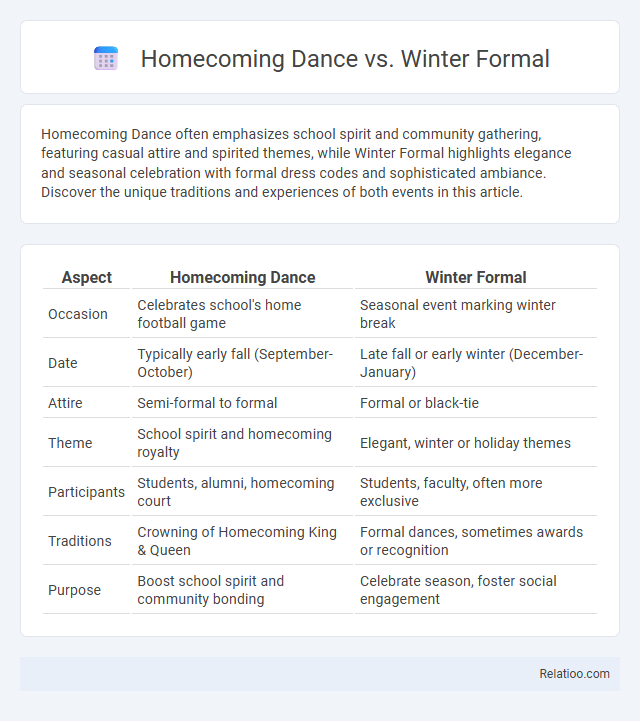Homecoming Dance often emphasizes school spirit and community gathering, featuring casual attire and spirited themes, while Winter Formal highlights elegance and seasonal celebration with formal dress codes and sophisticated ambiance. Discover the unique traditions and experiences of both events in this article.
Table of Comparison
| Aspect | Homecoming Dance | Winter Formal |
|---|---|---|
| Occasion | Celebrates school's home football game | Seasonal event marking winter break |
| Date | Typically early fall (September-October) | Late fall or early winter (December-January) |
| Attire | Semi-formal to formal | Formal or black-tie |
| Theme | School spirit and homecoming royalty | Elegant, winter or holiday themes |
| Participants | Students, alumni, homecoming court | Students, faculty, often more exclusive |
| Traditions | Crowning of Homecoming King & Queen | Formal dances, sometimes awards or recognition |
| Purpose | Boost school spirit and community bonding | Celebrate season, foster social engagement |
Introduction: Understanding Homecoming Dance and Winter Formal
Homecoming Dance and Winter Formal are popular school events that celebrate different times in the academic year, each offering unique social experiences. Homecoming Dance typically takes place in the fall, coinciding with football games and alumni reunions, while Winter Formal is a more elegant event held in the winter months, often featuring formal attire and a refined atmosphere. Understanding the differences helps you choose which event suits your preferences and social calendar.
Origins and History of Homecoming Dance
The Homecoming Dance originated in the early 20th century as a celebration welcoming alumni back to their high schools or colleges, often coinciding with football games and parades. Unlike Winter Formal, which typically emerged as a separate, elegant event during the colder months, the Homecoming Dance historically emphasized school spirit and community pride linked to autumn traditions. Homecoming itself encompasses a week of activities culminating in the dance, rooted in fostering alumni connections and boosting school morale through longstanding rituals dating back to the 1910s.
Origins and History of Winter Formal
Winter Formal originated in the mid-20th century as a seasonal counterpart to the traditional Homecoming dance, providing students an elegant social event during the colder months. Unlike Homecoming, which dates back to the early 1900s centered around welcoming alumni and celebrating football games, Winter Formal evolved largely in the 1950s and 1960s as schools sought to extend formal dance opportunities beyond autumn. This event emphasizes winter-themed decor and attire, distinguishing its historical and cultural significance within the high school social calendar.
Timing: When Do These Dances Take Place?
Homecoming Dance typically occurs in the early fall, coinciding with the homecoming football game, usually between September and October. Winter Formal is held during the winter months, often from December to February, offering a formal event after the holiday season. Homecoming events wrap up within weeks, whereas Winter Formal serves as a mid-year celebration for students.
Dress Code: What to Wear for Each Event
Homecoming Dance typically calls for semi-formal attire such as cocktail dresses or dress shirts with slacks, blending comfort with style suitable for a lively school event. Winter Formal demands more elegant, formal wear like long gowns or tuxedos, reflecting its upscale and festive ambiance often held in colder months. Homecoming, encompassing broader activities beyond the dance, often features casual to semi-formal dress codes depending on specific events like pep rallies or football games.
Themes and Decorations: Homecoming vs. Winter Formal
Homecoming dances typically feature autumn-themed decorations such as fall leaves, pumpkins, and school colors reflecting the football season spirit, creating a warm and spirited atmosphere. Winter Formal events embrace elegant, winter-inspired decor like snowflakes, icicles, fairy lights, and cool color palettes of silver, blue, and white to evoke a festive, sophisticated ambiance. The thematic focus of Homecoming centers on school pride and seasonal celebration, while Winter Formal emphasizes a glamorous, winter wonderland experience.
Student Participation and Traditions
Homecoming Dance typically garners the highest student participation with its emphasis on school spirit, pep rallies, and football games, creating a deeply rooted tradition in many high schools. Winter Formal attracts students seeking a more formal, elegant nighttime event often held during the colder months, featuring dinner and dancing without the accompanying game-day festivities. Your choice between Homecoming Dance and Winter Formal depends on whether you prefer a spirited, community-driven experience or a sophisticated social gathering.
Differences in Dance Activities and Entertainment
Homecoming Dance typically features a casual atmosphere with a mix of pop music, group dances, and themed decorations, encouraging school spirit and social interaction. Winter Formal offers a more elegant setting with formal attire, slower tempo music like ballroom or jazz, and activities such as formal dining or photo booths for a refined experience. Homecoming events concentrate on spirited pep rallies and football game celebrations, with dances serving as a secondary entertainment focused on inclusive, high-energy group participation.
Importance to School Spirit and Community
Homecoming Dance, Winter Formal, and Homecoming each play distinct roles in fostering school spirit and community engagement. Homecoming Dance and Homecoming events emphasize alumni involvement and student pride through traditional activities like pep rallies and sports games, creating a unified school identity. Winter Formal, often a more formal and seasonal celebration, boosts community by encouraging student socialization and enhancing the school's cultural atmosphere during the colder months.
Which Dance Is Right for You?
Homecoming Dance offers a lively, school-spirited atmosphere ideal for those wanting to celebrate with classmates and enjoy traditional festivities. Winter Formal provides a more elegant and seasonal setting, perfect if you prefer a classy night with formal attire and dancing. Your choice depends on whether you seek a casual, energetic event or a sophisticated, memorable evening.

Infographic: Homecoming Dance vs Winter Formal
 relatioo.com
relatioo.com